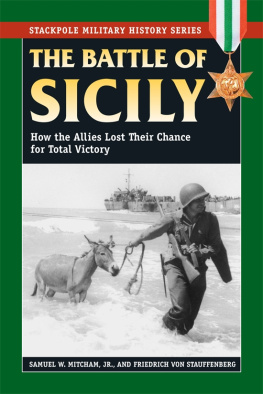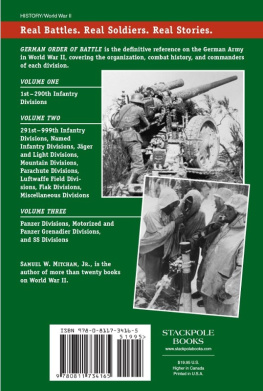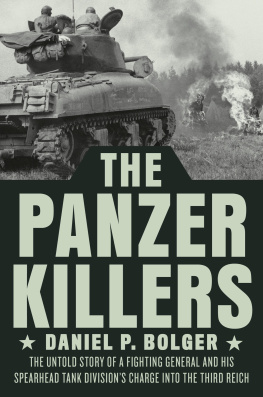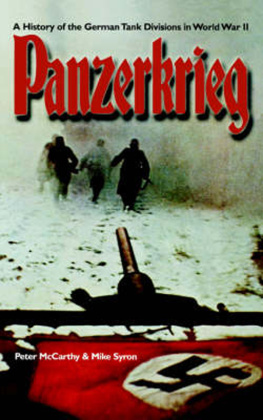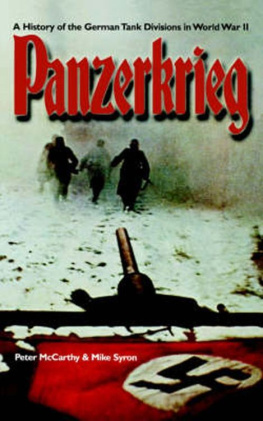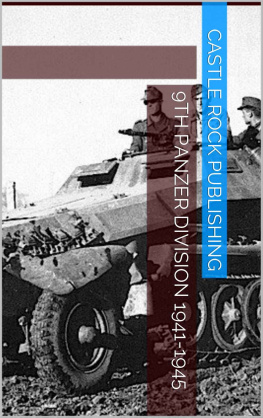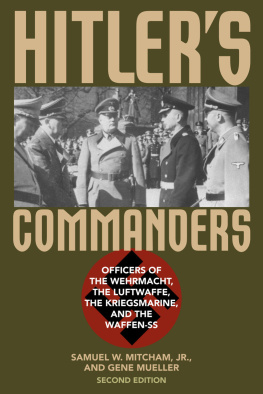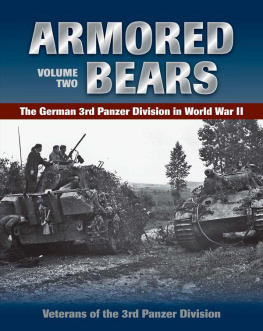Samuel W. Mitcham, Jr.






CONTENTS
PART I: THE PANZERWAFFE
Chapter
Chapter
PART II: THE PANZER DIVISIONS
PREFACE
Created in the 1930s, the German Panzer waffe (armored branch) revolutionized warfare for the rest of the 20th century, ending the era of the cavalry and nonmotorized infantry formation and replacing it with something far faster and more lethal. This era of mobile warfare is with us still: the advent of the helicopter was just another step in its logical development. Operation Desert Storm was a blitzkrieg campaign, and there will be others.
This book provides a guide to the World War II German Army tank divisions from inception to destruction and surrender. The guide is divided into two parts. Part I provides a generalized history of the panzer force. This part also includes a section on the German military districts (Wehrkreise), which were largely responsible for creating the panzer divisions, generally along the lines specified by the Panzer Inspectorate. This information on the Wehrkreise is critical to an understanding of how the German military system worked in World War II. It functioned so smoothly and so unspectacularly that it has generally gone unnoticed by historians, but without it Hitler could never have won his victories. Also, without the Wehrkreise's replacement and training system, it would have been impossible for Germany to have kept its divisions in the field for six years.
Part II of the book provides entries, arranged chronologically, giving the history of each individual division and its commanders. Full entries are included on the German Army tank divisions. Although the focus of the book is on the Army tank divisions, the SS panzer divisions are covered briefly. These divisions were not created until 1943, when the German defeat was inevitable and Hitler's distrust of his generals and the General Staff was such that he began to replace them with a Nazi Party organization (the SS). They had no effect on the evolution of the blitzkrieg. The German theories on employment of tank and mobile divisions was already fully in place by the time the first SS panzer division was created. This comment is not meant to minimize their importance; on the contrary, in the last two years of the war, the SS panzer divisions were exceedingly important, and they fought very well. Although the Waffen-SS (armed SS) fought side by side with the army, it was not part of it.
The histories of the motorized and panzer grenadier divisions are also not discussed in detail in this book. One exception is made: the elite Grossdeutschland Panzer Grenadier Divisions is covered as if it were a panzer division. This is because it was a panzer division-in everything but name. Many authors have cited it as a panzer division, but it was never officially designated as such, even when it had more panzers than almost any other German Army division. At a time when all the other army tank divisions had one or two panzer battalions, Grossdeutschland had three, and they were at nearly full strength. Also, the "G.D." Division is sometimes referred to as an SS unit. This is a myth-it never belonged to the SS.
The book also includes an index that should serve as a quick reference guide to individuals and panzer units.
I would like to thank all of the people who helped me in the preparation of this volume, especially my long-suffering wife, Donna. I would also like to thank the staffs of the U.S. Center for Military History at Carlisle Barracks, Pennsylvania; the U.S. National Archives; the Bundesarchiv; and the U.S. Air War College at Maxwell Air Force Base, Alabama. I would also like to thank Ms. Melinda Mathews and her interlibrary loan staff at the University of Louisiana at Monroe. Finally, thanks go to Dr. Heather Ruland Staines, military history editor at Greenwood, who is one of the best editors with whom I have had the privilege to work.
PART I
THE PANZERWAFFE
CHAPTER 1
THE HISTORY OF
THE PANZER FORCES
Germany was defeated in World War I, largely by the tank. When the war ended in November, 1918, it had only 45 tanks at the front. The Allies had more than 3,500.
After the war, Germany was forced to sign the Treaty of Versailles. Under its terms, the German Armed Forces (Reichswehr) was limited to 115,000 men: 100,000 in the army (Reichsheer) and 15,000 in the navy (Reichsmarine). Conscious of why they won the war, the victors prohibited the Reichswehr from having an air force, a tank force (or Panzerwaffe), poisonous gas, or submarines. Despite this fact, General Hans von Seeckt, the commander in chief of the Reichsheer and the creator of the Reichswehr, was more liberal in what he allowed for his forces. Field Marshal Erich von Manstein later recalled that Seeckt had an "inner fire that inspired him and the iron will which made him a leader of men."' He envisioned a future favorable for the creation of a panzer arm (among other things) and was largely responsible for molding that future into his image of it.
The Treaty of Versailles was so unfair and repugnant that most Germans viewed its violation as the equivalent of a patriotic act. In 1922, the German foreign minister met with his counterpart from the Soviet Union-the other ostracized power in Europe-and signed the Treaty of Rapallo. Under its secret protocols, Seeckt's representatives (Major General Curt Hasse and Colonel Kurt von Schleicher) could now hold discussions with Russian diplomats about establishing secret military bases in the Soviet Union. Negotiations were protracted, but the Reichsheer was eventually able to establish three training centers in Russia: a gas school at Saratov, an aviation school near Lipetsk, and an armored training school near Kazan, on the Kama River. It was unofficially dubbed Pan- zertruppenschule Kama. Training lasted up to two years. Up to a dozen officers trained there at a time. Its directors of training included tank pioneer Major (later Lieutenant General) Ritter Ludwig von Radlmaier and Major (later Colonel General) Josef Harpe, who later commanded the 5th Panzer Army. Visiting observers included Major General (later Field Marshal and Minister of War) Werner von Blomberg, Major General Oswald Lutz, Lieutenant Colonel Heinz Guderian, and Lieutenant Colonel (later Field Marshal) Walter Model, among others. Ritter Wilhelm von Thoma, future commander of the Afrika Korps, was also associated with the school. By the late 1920s, the German firms of Krupp, Daimler, and Rheinmetall had all sent engineers and technicians to Kazan, where they worked on new tank designs-including what became the Panzer- kampfwagen 1 and 11-the Panzer Mark I (PzKw I) and Mark II (PzKw II), respectively!


